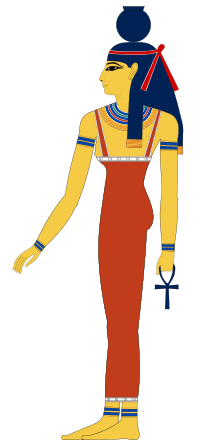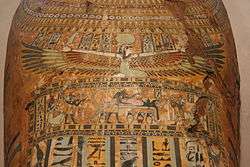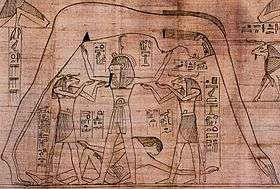Nut (goddess)
| Nut | |||
|---|---|---|---|
| Goddess of the Sky and Heavens | |||
 The goddess Nut, wearing the water-pot sign (nw) that identifies her. | |||
| Name in hieroglyphs |
| ||
| Symbol | the Sky, Stars, Cows | ||
| Consort | Geb | ||
| Parents | Shu and Tefnut | ||
| Siblings | Geb | ||
| Offspring | Osiris, Isis, Set, Nephthys, and sometimes Horus | ||
Nut (also Nunut, Nuit, Nenet,[1] Naunet, Newet) is the goddess of the sky in the Ennead of ancient Egyptian religion. She was seen as a star-covered nude woman arching over the earth,[2] or as a cow.
Goddess of the sky
Nut is a daughter of Shu and Tefnut. Her husband and brother is Geb. She has four children: Osiris, Set, Isis, and Nephthys. Her name is translated to mean 'sky'[n 1][3] and she is considered one of the oldest deities among the Egyptian pantheon,[4] with her origin being found on the creation story of Heliopolis. She was originally the goddess of the nighttime sky, but eventually became referred to as simply the sky goddess. Her headdress was the hieroglyphic of part of her name, a pot, which may also symbolize the uterus. Mostly depicted in nude human form, Nut was also sometimes depicted in the form of a cow whose great body formed the sky and heavens, a sycamore tree, or as a giant sow, suckling many piglets (representing the stars).
Origins

A sacred symbol of Nut was the ladder, used by Osiris to enter her heavenly skies. This ladder-symbol was called maqet and was placed in tombs to protect the deceased, and to invoke the aid of the deity of the dead. Nut and her brother, Geb, may be considered enigmas in the world of mythology. In direct contrast to most other mythologies which usually develop a sky father associated with an Earth mother (or Mother Nature), she personified the sky and he the Earth.[5]
Nut appears in the creation myth of Heliopolis which involves several goddesses who play important roles: Tefnut (Tefenet) is a personification of moisture, who mated with Shu (Air) and then gave birth to Sky as the goddess Nut, who mated with her brother Earth, as Geb. From the union of Geb and Nut came, among others, the most popular of Egyptian goddesses, Isis, the mother of Horus, whose story is central to that of her brother-husband, the resurrection god Osiris. Osiris is killed by his brother Set and scattered over the Earth in 14 pieces which Isis gathers up and puts back together. Osiris then climbs a ladder into his mother Nut for safety and eventually becomes king of the dead.[6]
A huge cult developed about Osiris that lasted well into Roman times. Isis was her husband's queen in the underworld and the theological basis for the role of the queen on earth. It can be said that she was a version of the great goddess Hathor. Like Hathor she not only had death and rebirth associations, but was the protector of children and the goddess of childbirth.[6]
Myth of Nut and Ra
Ra, the sun god, was the second to rule the world, according to the reign of the gods. Ra was a strong ruler but he feared anyone taking his throne. When he discovered that Nut was to have children, he was furious. He decreed, "Nut shall not give birth any day of the year." At that time, the year was only 360 days. Nut spoke to Thoth, god of wisdom, and he had a plan. Thoth gambled with Khonsu, god of the moon, whose light rivalled that of Ra's. Every time Khonsu lost, he had to give Thoth some of his moonlight. Khonsu lost so many times that Thoth had enough moonlight to make 5 extra days. Since these days were not part of the year, Nut could have her children. She had five children: Osiris, later ruler of the gods and then god of the dead, Horus the Elder, god of war, Set, god of evil and wastelands, Isis, goddess of magic, and Nephthys, goddess of water. When Ra found out, he was furious. He separated Nut from her husband Geb for eternity. Her father, Shu, was to keep them apart. Nevertheless, Nut did not regret her decision.
Some of the titles of Nut were:
- Coverer of the Sky: Nut was said to be covered in stars touching the different points of her body.
- She Who Protects: Among her jobs was to envelop and protect Ra, the sun god.[7]
- Mistress of All or "She who Bore the Gods": Originally, Nut was said to be lying on top of Geb (Earth) and continually having intercourse. During this time she birthed four children: Osiris, Isis, Set, and Nephthys.[8] A fifth child named Arueris is mentioned by Plutarch.[9] He was the Egyptian counterpart to the Greek god Apollo, who was made syncretic with Horus in the Hellenistic era as 'Horus the Elder'.[10] The Ptolemaic temple of Edfu is dedicated to Horus the Elder and there he is called the son of Nut and Geb, brother of Osiris, and the eldest son of Geb.[11]
- She Who Holds a Thousand Souls: Because of her role in the re-birthing of Ra every morning and in her son Osiris's resurrection, Nut became a key god in many of the myths about the afterlife.[7]
Role

Nut was the goddess of the sky and all heavenly bodies, a symbol of protecting the dead when they enter the afterlife. According to the Egyptians, during the day, the heavenly bodies—such as the sun and moon—would make their way across her body. Then, at dusk, they would be swallowed, pass through her belly during the night, and be reborn at dawn.[12]
Nut is also the barrier separating the forces of chaos from the ordered cosmos in the world. She was pictured as a woman arched on her toes and fingertips over the earth; her body portrayed as a star-filled sky. Nut’s fingers and toes were believed to touch the four cardinal points or directions of north, south, east, and west.
Because of her role in saving Osiris, Nut was seen as a friend and protector of the dead, who appealed to her as a child appeals to its mother: "O my Mother Nut, stretch Yourself over me, that I may be placed among the imperishable stars which are in You, and that I may not die." Nut was thought to draw the dead into her star-filled sky, and refresh them with food and wine: "I am Nut, and I have come so that I may enfold and protect you from all things evil."[13]
She was often painted on the inside lid of the sarcophagus, protecting the deceased. The vaults of tombs were often painted dark blue with many stars as a representation of Nut. The Book of the Dead says, "Hail, thou Sycamore Tree of the Goddess Nut! Give me of the water and of the air which is in thee. I embrace that throne which is in Unu, and I keep guard over the Egg of Nekek-ur. It flourisheth, and I flourish; it liveth, and I live; it snuffeth the air, and I snuff the air, I the Osiris Ani, whose word is truth, in peace.''
Book of Nut
The Book of Nut is a modern title of what was known in ancient times as The Fundamentals of the Course of the Stars. This is an important collection of ancient Egyptian astronomical texts, perhaps the earliest of several other such texts, going back at least to 2,000 BC. Nut, being the sky goddess, plays the big role in the Book of Nut. The text also tells about various other sky and earth deities, such as the star deities and the decans deities. The cycles of the stars and the planets, and the time keeping are covered in the book.[14]
Notes
- ↑ The hieroglyphics (top right) spell nwt or nut. Egyptians never wrote Nuit. (Collier and Manley p. 155) The determinative hieroglyph is for 'sky' or 'heaven', the sky (hieroglyph).
References
- ↑ Budge, An Egyptian hieroglyphic dictionary (1920), p. 350.
- ↑ Cavendish, Richard (1998). Mythology, An Illustrated Encyclopaedia of the Principal Myths and Religions of the World. ISBN 1-84056-070-3.
- ↑ Wörterbuch der Ägyptischen Sprache, edited by Adolf Erman and Hermann Grapow, p 214, 1957
- ↑ The Oxford Encyclopedia of Ancient Egypt, by Leonard H. Lesko, 2001
- ↑ Women of Ancient Egypt and the Sky Goddess Nut, by Susan Tower Hollis The Journal of American Folklore © 1987 American Folklore Society.
- 1 2 "Egyptian goddesses" The Oxford Companion to World mythology. David Leeming. Oxford University Press, 2004. Oxford Reference Online. Oxford University Press. Southeast Missouri State University. 7 May 2009
- 1 2 The Oxford Encyclopedia of Ancient Egypt, by Leonard H. Lesko, 2001.
- ↑ Clark, R. T. Rundle. Myth and Symbol in Ancient Egypt. London: Thames and Hudson, 1959.
- ↑ The Moralia - Isis & Osiris, 355 F, Uchicago.edu
- ↑ Encyclopaedia Britannica, Google Books
- ↑ Emma Swan Hall, Harpocrates and Other Child Deities in Ancient Egyptian Sculpture, Journal of the American Research Center in Egypt Vol. 14, (1977), pp. 55-58, retrieved from JSTOR.org
- ↑ Hart, George Routledge dictionary of Egyptian gods and goddesses Routledge; 2 edition (15 March 2005) ISBN 978-0-415-34495-1 p.111 Books.google.co.uk
- ↑ "Papyrus of Ani: Egyptian Book of the Dead", Sir Wallis Budge, NuVision Publications, page 57, 2007, ISBN 1-59547-914-7
- ↑ Alexandra von Lieven: Grundriss des Laufes der Sterne. Das sogenannte Nutbuch. The Carsten Niebuhr Institute of Ancient Eastern Studies, Kopenhagen 2007.
Bibliography
- Mark Collier and Bill Manley (1998). How to Read Egyptian Hieroglyphs: Revised Edition. Berkeley: University of California Press.
- Leeming, David (2004). Egyptian goddesses: The Oxford Companion to World mythology. Oxford University Press.
- Sir Wallis Budge (2007). Papyrus of Ani: Egyptian Book of the Dead. NuVision Publications. p. 57.
- Leonard H. Lesko (2001). The Oxford Encyclopaedia of Ancient Egypt.
- Hollis, Susan Tower (1987). Women of Ancient Egypt and the Sky Goddess Nut.
- Willems, Harco (1988). Chests of life "Chests of Life" Check
|url=value (help). pp. 131–144, 165, 168, 174, 194–196, 243.
Further reading
- Lesko, Barbara S. (1999). The Great Goddesses of Egypt. University of Oklahoma Press. ISBN 0-8061-3202-7.
- Billing, Nils (2002). Nut, the Goddess of Life: In Text and Iconography. Department of Archaeology and Ancient History, Uppsala University. ISBN 9150616536.
- Billing, Nils (2004). "Writing an Image—The Formulation of the Tree Goddess Motif in the Book of the Dead, Ch. 59". Studien zur Altägyptischen Kultur. 32. JSTOR 25152905.
- Roberts, Alison (2000). My Heart My Mother: Death and Rebirth in Ancient Egypt. NorthGate Publishers. ISBN 0-952-4233-16.
External links
 Media related to Nut (goddess) at Wikimedia Commons
Media related to Nut (goddess) at Wikimedia Commons Quotations related to Nut (goddess) at Wikiquote
Quotations related to Nut (goddess) at Wikiquote